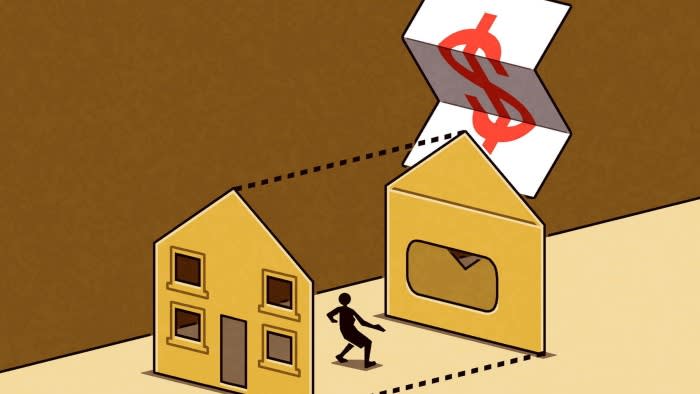Unlock the Editor’s Digest for free
Roula Khalaf, Editor of the FT, selects her favourite stories in this weekly newsletter.
It’s no secret that there’s a housing crisis in America. Shelter has accounted for the bulk of core inflation over the past couple of years.
But even if you can afford a home, you may not be able to insure it. The cost of homeowner’s insurance in the US rose 23 per cent from January 2023 to February 2024, even as coverage in many places is decreasing. In hurricane-prone Louisiana, premiums were up 63 per cent. States such as Florida are becoming uninsurable, as providers pull out of the market altogether.
The obvious driver here is climate change and the risk of more severe weather events, such as floods, fires, wind storms and tornadoes. But there are other factors in play too. These include the slow adoption of risk mitigation technologies, the failure of insurers, banks and public officials to come up with joint approaches to cost sharing and the huge opacity in the market — at least for consumers.
I am one of many to have experienced this. A couple of months ago, my insurance company decided to raise the price of the yearly insurance premiums on our Brooklyn home by 51 per cent over three years, after more than doubling the estimated cost to rebuild should it burn to the ground or be washed away in a hurricane.
While neither outcome seems likely for a limestone townhouse that sits on a hill more than a mile and a half away from the nearest flood zone, our insurer came up with an estimate that was more than double what the house would go for on the open market, making coverage both excessive and unaffordable. When I raised all this in an email with the risk assessor who had inspected our home, I received no response.
In shopping around for a new insurer, I discovered the hugely bifurcated and inefficient market that Americans are currently grappling with. No one was willing to sell us a premium for the market value of our home and simultaneously prepared to write us a cheque for that value in case of total loss. We had two choices. Take out a policy with a handful of luxury insurers that would only sell us far greater coverage than we wanted for much more than we could afford. Or go with a budget policy offering roughly a third of what it would cost to buy a similar home in the case of a total loss — with the money only paid out if we chose to rebuild on site.
In essence, that means that if our house burns down, we’ll be left with just the value of the lot (not nothing, but not ideal). Sadly, this isn’t uncommon, in New York and many other places across America. Both options seemed nuts, but only one was affordable. We went with the inexpensive policy, bought four fire extinguishers and made peace with the fact that if our home were ever gutted, we would sell the lot and move to a place where housing is exponentially cheaper.
All this was particularly infuriating because we have any number of friends with similar homes who are paying wildly different prices for insurance. When I asked our broker how it was possible, or even legal, for a neighbour with the same insurer and the exact same house three doors away to pay a bit more than half our new quote, she told us that their premiums would very likely be raised next. And while we could take the issue to the state regulators, she suspected they were being cautious about acting since New York is at risk of becoming a new Florida and uninsurable if officials pressed insurers too hard.
How could there be so few options, so little transparency and such tolerance of inflation and inefficiency in a market as big as New York? Why was my home, which has never been seriously damaged by weather, being risk-assessed like something in a hurricane flood zone that is more than a mile and a half away? Why is the insurance industry so bad at pricing risk in a more precise way around the city, and indeed, much of the rest of the country?
Is there not technology that could properly assess such differences, perhaps sensors placed in the home to assess whether a particular property was at risk of wind damage or actually had water regularly in the basement? “I don’t know,” our broker said, adding that she fielded such questions every day. “Maybe call Lloyd’s of London.”
So, I did. Lloyd’s is the world’s oldest insurance marketplace, and its chief executive John Neal told me that the home insurance market, particularly in coastal America, “has reached a tipping point”. While high tech flood-detection systems are starting to be available, they haven’t been widely adopted (and would probably only be for those rich enough to pay for them).
More crucially, he said, “banks, insurers, regulators and governments haven’t sat down and discussed how to share risk responsibility”. While climate is changing, the model for insurance has not. The premiums of the many still pay for the losses of the few. But those losses are increasing, and neither the public nor private sector has yet grappled with the full ramifications of this. Individuals are left to struggle through it alone.
Given the cost of premiums, something has to change. Certainly, there’s a market opportunity for more innovative and efficient insurers. But I suspect that coastal states, backed up by reinsurers, will also have to lower the risks to homes by building flood walls and better drainage systems in vulnerable areas. This means charging higher taxes to pay for them.
Until that happens, individual homeowners will have to make their peace with the prospect of nosebleed premiums or big potential losses.
rana.foroohar@ft.com


